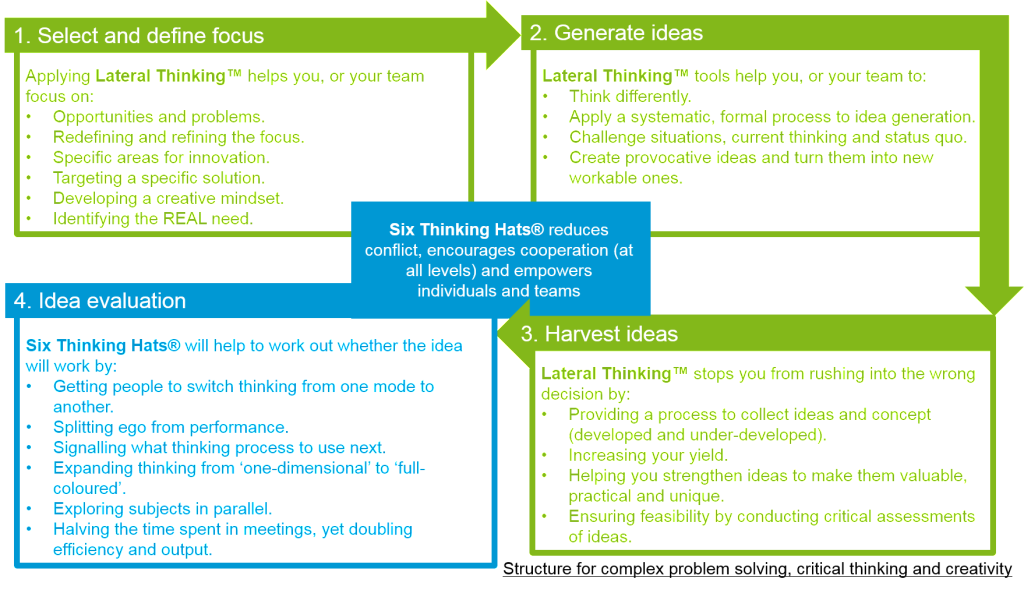Many organisations have mission or vision statements that suggest they are an innovative or creative organisation, yet the people at the top of the organisation can often not elaborate on how, or if this happens. Often just putting people in a room, without a creative structure to follow, telling them to ‘be creative’.
In the 2012 IBM Global CEO Study, over 60% of the survey respondents say that creative leadership is the number one quality for CEOs and their ability to develop creativity in an organisation, yet most have little or no creative processes to refer to or utilise.
The IBM Cultivating Organizational Creativity In An Age Of Complexity Study also discusses three imperatives to ‘accelerate the development of creative capital’, these are:
- Uncover the key capabilities of the creative organisation.
- Unlock and catalyse the creative capabilities of leaders.
- Unleash and scale organisational creativity.
Source: www-935.ibm.com/services/us/gbs/thoughtleadership/ibv-organizational-creativity.html
Further research by McKinsey found that four kinds of leadership behaviour account for 89% of leadership effectiveness. Leaders in organisations with high-quality leadership demonstrated that they:
- Operate with a strong results orientation.
- Support others.
- Solve problems effectively.
- Seek different perspectives.
Solving problems and seeking different perspectives are core elements of complex problem solving, critical thinking and creativity. To be able to do this you will need to adopt creative thinking processes.
Where does creativity sit in your organisation?
Often ideas are typically stored in people’s minds or sat, as long lists on a flip chart, after a ‘brainstorming’ session – never to see the light of day. You may even find that people are not buying into the ideas that are generated by middle management, as the decision was imposed with no collaboration. These situations are true of many organisations, most of which have pockets of creativity-focused teams – but no over-arching supportive culture.
To develop a culture that includes innovation and creativity you need to look at a top-down approach. As a business leader or senior manager you’ll already know that your business and your people will stagnate without new ideas. Without new ideas your organisation won’t move forward or create competitive advantage. You need to lead from the top, maintaining discipline to ensure things get done, and empower your employees or team by unlocking creativity for them.
Unlocking creativity.
The 2016 Davos Forum has highlighted that the top three core work-related skill requirements for organisations in 2020 will be:
- Complex problem solving.
- Critical thinking.
- Creativity.
In order to solve problems your organisation needs to be creative, to be able to generate and evaluate ideas without losing focus. Critical thinking and creativity are skills that can be learnt, no matter what level. There is a structure that can be developed within an organisation using two proven techniques from Edward de Bono.
The structure, through experiential learning, provides practical tools that can be implemented in real business challenges to generate and implement ideas. The techniques shown in the example above are Edward de Bono’s Lateral Thinking and Edward de Bono’s Six Thinking Hats®, both designed to generate and implement ideas that will bring you great results and ROI. Providing the organisation with a structured, collaborative approach to problem-solving, idea generation and creativity. So leaders will be more aligned to direct and deliver an innovative culture where motivation and trust provide positivity.
Efficient, effective and collaborative.
Forrester Consulting investigated how creativity influences business outcomes in 2014. They found that leaders and managers who embed the creative process into an organisation’s culture benefit from:
- Improved revenue, increased market share and have high-performing people.
- A motivated, engaging work environment with reduced conflict.
Talk to us about how we can help organisations like yours to improve internal creative thinking, using two key creative thinking and idea generation workshops:
 Beccie Varney is a Leadership and Management Development Consultant at Indigo with more than 20 years of people management, and learning and development experience. Working with all levels, she is passionate about helping people get to the top of their game through innovative solutions; incorporating effective organisation skills, true management of time, and effective communication skills.
Beccie Varney is a Leadership and Management Development Consultant at Indigo with more than 20 years of people management, and learning and development experience. Working with all levels, she is passionate about helping people get to the top of their game through innovative solutions; incorporating effective organisation skills, true management of time, and effective communication skills.



